Fencers! It's time for another bit of fencing history on this blog. The second half of our two-part series about the development of foil, to be precise. Written by our usual expert in the matter: Malcolm Fare. So, let's continue where we left off and go back to the late 19th century. 1896 was going to be a special and decisive year for modern foil fencing in more than one regard....
Three key events in the history of fencing occurred in 1896:
- Rules for civilian competitions in Britain were first drawn up by the Amateur Gymnastic & Fencing Association. They reflected those adopted by the Royal Tournament, except that the width of the piste was extended to 6 ft. Hits were valid between neck and hips, and included the mask or arms if covering the target. The buttons of foils were coloured to aid the referee and judges, and competitors were expected to acknowledge hits. Any fencer wilfully refraining from acknowledging had a point scored against him for each offence.
- The first modern Olympic Games gave a great stimulus to fencing as a sport with the inclusion of foil and sabre competitions.
- Later that year the first open international three-weapon events were held in Paris, with separate competitions for amateurs and professionals. The winner of each event received 1000 francs and every participant received a bronze medal commemorating the tournament.
The first British foil championship was held in 1898 and the winner was not required to fence in the following year’s championship until the final poule. Only in 1910 did the champion have to fence through the competition like everyone else.
When the Amateur Fencing Association was formed in 1901, bouts were for three hits, but unorthodox fencers could sometimes beat skilled opponents with a few lucky touches. So, in 1905, the scoring system was changed to an unlimited number of hits within a 5-minute period, taking into account the quality of the fencing as well as the hits scored. At the end of the final bout of the foil championship that year between Robert Montgomerie and Edgar Seligman, both previously unbeaten, the score in hits was 5-4 to Seligman, but Montgomerie
[Fig. 1] was declared the winner because of his superior style. In practice, however, the judging of style proved to be too inconsistent and was soon dropped.
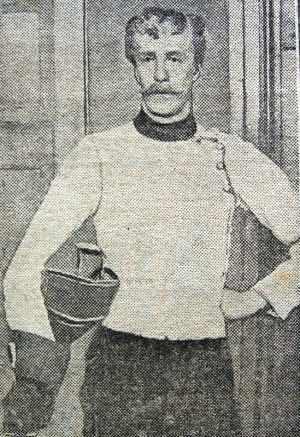 Fig. 1: Robert Montgomerie
Fig. 1: Robert Montgomerie
Fencing started to become an acceptable pastime for women in the late 1880s, when the Prince of Wales sent his three daughters to Baptiste Bertrand for instruction.
[Fig. 2 shows Bertrand’s salle for women.]
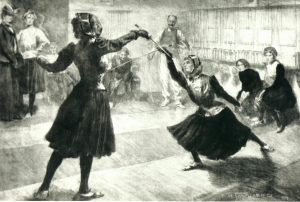 Fig. 2: Salle Bertrand
Fig. 2: Salle Bertrand
Within 10 years the formidable Toupie Lowther
[Fig. 3] was defeating all her opponents, including many men.
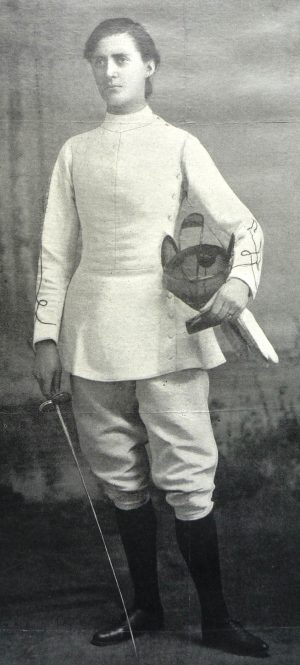 Fig. 3: Toupie Lowther
Fig. 3: Toupie Lowther
But she had retired by the time the first British women’s foil championship was held in 1907, Millicent Hall
[Fig. 4] winning from a field of 37 competitors.
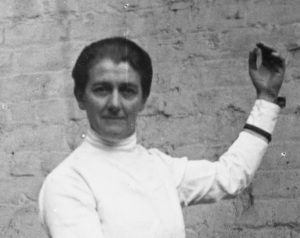 Fig. 4: Millicent Hall
Fig. 4: Millicent Hall
It was not until 1924 that women’s foil was accepted at the Olympic Games.
Anxious to make foil fencing more practical, the French Ministry of War introduced new regulations in 1908 that extended the target (for men) to include the lines of the groin and the upper sword arm from shoulder to elbow. When the organisers of the 1912 Olympics reverted to the old target definition of the body between neck and hips, the French team withdrew in protest. The time had clearly come for an international body to draw up a set of rules that everyone would adhere to and, in 1913, the FIE was formed. Its basic specifications for the foil hold good to this day: blades must be not more than 900 mm long, guards not more than 120 mm in diameter and 30-55 mm deep, and total weight not more than 500 g.
Although the upper arm was part of the valid target at the 1920 Olympics, it was excluded three years later, too late for the young Italian star Aldo Nadi
[Fig. 5], who famously lost the most publicised match of the 20
th century to Lucien Gaudin of France
[Fig. 6] in 1922, complaining bitterly that several hits had been given against him when they landed on his arm.
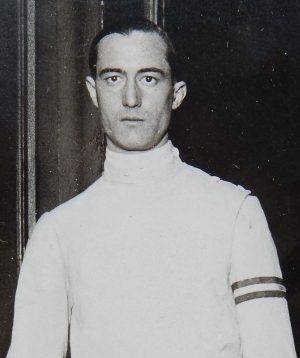 Fig. 5: Aldo Nadi
Fig. 5: Aldo Nadi
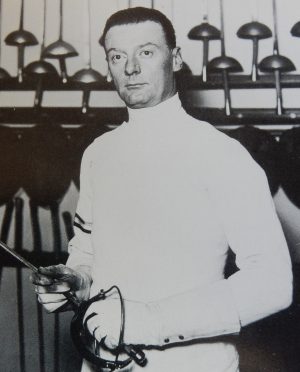 Fig 6: Aldo Nadi's opponent Lucien Gaudin
Fig 6: Aldo Nadi's opponent Lucien Gaudin
For women, the lower limit of the target remained at a line drawn across the top of the hipbones and in 1938 the FIE ruled that it should be marked by a black ribbon sewed across the jacket. In 1964 the women’s target was finally made the same as the men’s.
For more than 200 years the shape of the handle was a simple choice between French and Italian. After a period in the 18
th century when foils were fitted with oval handles to resemble their smallsword counterparts, the French adopted the more practical square shape, which offered a high degree of blade manipulation. By contrast, the Italians remained faithful to a short rapier-style handle with crossbar over which two fingers were placed to retain strong control of the blade. It was not until the 20
th century that a more physical style of fencing made it necessary to develop handles that gave a stronger grip. One of the first to have an orthopedic handle designed to his requirements was the French champion Edouard Gardère, who used it during the 1932 Olympics. Its popularity soon spread and with the introduction of electric foil a wide variety of pistol-type handles became available.
Experiments with electric foil began in the 19
th century. Towards the end of his life, the French magician and fencer Robert-Houdin (1805-1871) is said to have invented a metallic jacket linked by wire to a bell that rang when the jacket was touched by a foil point. He gave the rights to this invention to his friend, the fencing master Augustin Cabot, who registered a patent in 1895. Another electric scoring apparatus was developed in Belgium in 1885 and in 1896 the English surgeon Muirhead Little invented a similar device involving an electric wire connecting a jacket woven with copper thread to a wall-mounted recorder
[Fig. 7].
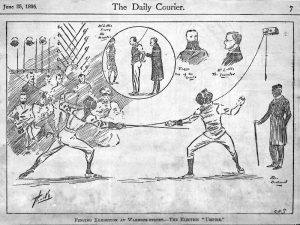 Fig. 7: Electric Umpire
Fig. 7: Electric Umpire
But, although they were successfully demonstrated, the sight of two fencers moving up and down the piste on wires like a couple of captive beetles caused such hilarity among spectators that the systems lost all credibility.
It was not until 1935 that the familiar reel and ground lead system was first tried out using a Hungarian scoring machine in a women’s foil match in Germany. Two years later the FIE initiated the first men’s foil international electric tournament in Brussels, using an apparatus developed by the Italian engineer Sergio Carmina.
In 1938 Bela de Tuscan, a Hungarian-born fencing master from Detroit, patented an ingenious battery-operated system and demonstrated it with his wife Joanna on stage in London. A wire led from a battery inside a transparent bell guard and along a channel cut into the foil blade with the tip of each blade slightly recessed. The fencers wore jackets with the target area covered with a thin layer of metallic cloth. When the blade hit the cloth, a light came on inside the guard to indicate who had scored a hit, but not if the hit was off-target. Another display involved connecting a miniature light bulb to the end of their foils so that, on a darkened stage, they could trace fencing moves
[Fig. 8]. World War II put a stop to further development.
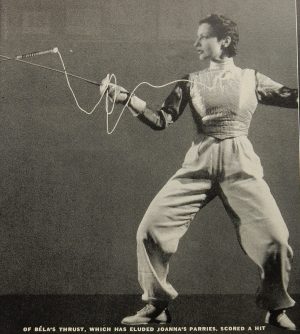 Fig. 8 Joanna de Tuscan uses a light-bulb-tipped foil
Fig. 8 Joanna de Tuscan uses a light-bulb-tipped foil
After the war, an experimental electric poule (won by Britain’s René Paul) was held at the time of the 1950 world championships. But only in 1955 did enough reliable equipment become available for the foil events at the world championships to be fenced electric for the first time. However, the blades were about 65 g heavier than non-electric ones and the resulting lack of balance caused many foilists to give up the weapon in disgust. But the best fencers adjusted, as demonstrated by the Frenchman Christian D’Oriola, who won the gold medal at both the non-electric 1952 Olympics and the electric 1956 Games. It was in 1956 that Gillian Sheen
[Fig. 9] became Britain’s first and, so far, only Olympic gold medallist. In those early days, it was felt that referees would be so pressurised that they would not be able to work for more than 15 minutes at a time.
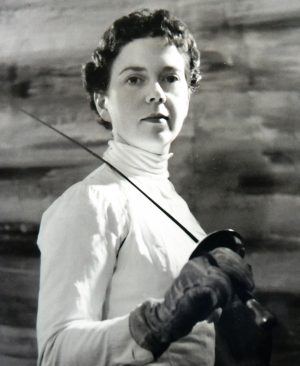 Fig. 9 Gilliam Sheen/em>
Fig. 9 Gilliam Sheen/em>
At the 1955 world championships the Russians demonstrated an invention that was suggested could replace the costly electric foil. It consisted of a hollow spring-loaded point containing a wad of cotton wool that was impregnated with a mix of water, red dye and ammonia before each bout. When a hit was made that caused the point to be depressed, a red mark appeared, disappearing a few seconds later depending on the amount of ammonia in the mixture. But, apart from the inconvenience of having to regularly replenish the mixture, the system did not work on metal and so off-target hits on the wire mesh of the mask did not register. Like other ingenious devices for recording hits developed over the previous 250 years, it passed into oblivion.
Early electric tips had a distinctive beehive shape with horizontal and vertical ridges, then in 1958 the vertical ridges were removed and in 1961 a flat tip with sharp edges was introduced. Seven years later the bevelled edge version that we know today became the standard shape, although its diameter has changed over the years.
[Fig. 10]
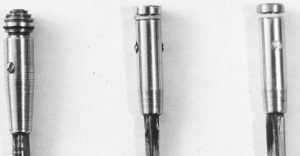 Fig. 10: Electric foil tips through the years
Fig. 10: Electric foil tips through the years
But blades continued to break, sometimes with fatal consequences and it was only in 1995 that maraging steel, a high-strength iron-nickel alloy, was introduced for foil and epee blades, which not only lasted longer than blades made of spring steel, but also tended to fail progressively so that they could be discarded before breaking.
All wired links in electrical fencing can develop faults and ever since Wilkinson Sword began experimenting with radio transmitters in the 1950s, engineers have been trying to develop a reliable wireless scoring system. A promising French invention was demonstrated in the 1960s, but was never funded to commercial development, and it was not until the late 1990s that a Ukrainian company, StM, introduced a system, initially for sabre, that worked reliably. It was used at the world championships for the first time in 2001 and at the Olympics in 2004, before being adapted to epee at the 2007 world championships and finally to foil at the 2008 Olympics. Since then it has been used in the final stages of all major tournaments. Competitors wear a special conductive T-shirt next to their skin. A hit activates a transmitter attached to the fencer's waist, which triggers a light on the mask and transmits a signal to the scoreboard in the arena. A sophisticated encoding system solves problems of interference from any other transmitter.
[Fig. 11 shows foilists at the 2011 world championships.]
 Wireless fencing in 2011
Wireless fencing in 2011
Malcolms historical overview ends in 2011, dear readers, but we don't want to keep the latest updates in wireless fencing from you, and asked our director (and head of product development) Alex Paul to continue the story for you:
Where the current STM wireless system relies on engineers adjusting the system for the individual fencer in the call room we wanted to develop something that would work for everyone without the need for specialist set up. This task has taken many years of hard work but in 2016 we released a consumer wireless system in 2016 aimed at club fencers. This system has proved very popular as it is very quick to setup and perfectly suits club fencing when the venue is shared with other activities. We are currently working on a version of the hardware for competition use which we hope to release in early 2019.
 Fig. 1: Robert Montgomerie
Fig. 1: Robert Montgomerie Fig. 2: Salle Bertrand
Fig. 2: Salle Bertrand  Fig. 3: Toupie Lowther
Fig. 3: Toupie Lowther Fig. 4: Millicent Hall
Fig. 4: Millicent Hall Fig. 5: Aldo Nadi
Fig. 5: Aldo Nadi Fig 6: Aldo Nadi's opponent Lucien Gaudin
Fig 6: Aldo Nadi's opponent Lucien Gaudin Fig. 7: Electric Umpire
Fig. 7: Electric Umpire  Fig. 8 Joanna de Tuscan uses a light-bulb-tipped foil
Fig. 8 Joanna de Tuscan uses a light-bulb-tipped foil Fig. 9 Gilliam Sheen/em>
Fig. 9 Gilliam Sheen/em> Fig. 10: Electric foil tips through the years
Fig. 10: Electric foil tips through the years Wireless fencing in 2011
Wireless fencing in 2011
